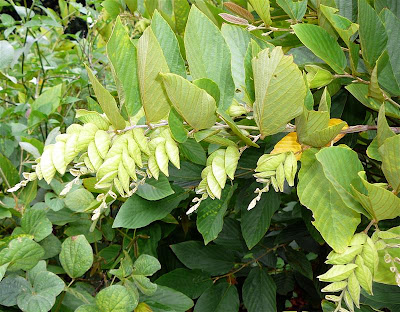Recently my trips to Pulau Ubin, an isle of tranquility and rustic charm, has been quite stressful ones because I was busy with my Chek Jawa project. This time finally, I could take a Sunday late afternoon off to relax and soak myself in what nature has to offer. With me are fellow nature lovers: Ron, July, Justin and Ivan.
The bumboat arrives at the jetty during low tide and the jetty exposed masses of green mussels scattered all over the pillars.
And these mussels seemed to have grown bigger from the last time I saw them. They are growing evening near staircase of the jetty.
The invasive mussel beds have arrived on the mangrove shore of the jetty. They settle well on the rocks.
We went to the butterfly hill first and Ron introduced to us this native plant called Flemingia strobilifera. These plants have modified leaves called bracts which has little flowers or fruits inside them. He also shared with us that people uses the dried bracts for stuffing pillows and cushions.
This plant that can be usually found by the coast is the sea lettuce (Scaveola sericea). These shrubs have leaves that are large and waxy. The waxy leaves prevent water loss especially when salt sprays and exposure to high sunlight are common by the coast which dessicates the plant. The little white flowers of the sea lettuce also have a unique structure developing into a round fruit.
These flowers belong the the hoya plant. Hoyas are climbing vines or shrubs which have simple opposite leaves. Many species of hoya are popular house plants especially in temperate areas because of their beautiful flowers which can give off strong scents.
A symbiotic relationship can be found in these ant-house plants. The ants tend to live within the hollows of the leaves. The plants provide food or shelter to the ants while the ants provide protection or nutrients to the plant.
By a fence, we saw many of these Tawny Coster (Acraea violae) caterpillars where they are cylindrical, slender, with six longitudinal rows of fine branched spines. These caterpillars however will grow into small leathery winged butterflies which are common in grassland and scrub habitats.
I always wanted to visit the heronry at the quarry and finally had the chance to see it.
Another angle of the heronry.
Appareantly, the dead fall or log of trees become perfect homes for these grey herons.
And we speculated that this special nest on top of the tree belongs to an eagle.
Walking along the track towards our second destination to Puaka hill, we saw quie a number of Golden Orb Web Spiders (Nephila maculata). These spiders though not the largest spiders, make the largest and strongest web. They get their name from the golden colour of its silk. More information on these spiders from Ria's sungei buloh factsheet.
We also came across mangrove portion during low tide.
And on the mangrove flat, there were quite a number of blue-spotted mudskippers (Boleophthalmus boddarti).
This little heron (Butorides striatus) was also on the flats, apparently looking for food. According to Ria's Sungei Buloh factsheet, these birds hunched into a compact egg-shape on a branch over the water, motionless but intently looking out for prey. They eat mainly small fish and crustacea (especially crabs). They also take amphibians and insects and any other edible titbits, including small mammals.
We finally reached the foot of Puaka Hill and started climbing up. Along the way, I saw the nest of weaver ants (Oecophylla smaragdina). Weaver Ants' nests are among the most complex ants' nests. Interestingly, weaver ants eat any small creatures that they can find, but they are particularly attracted to nectar. Learn more from Ria's Sungei Buloh factsheet again :-)
Spectacular bird eye's view greeted at the highest point of ubin at about 58 metres height.
At the top, we could see Changi Airport at mainland Singapore.
To be continued...


































3 comments:
Hi there! It's pesky me again. ;-D
Glad to see that the Tawny Costers are doing well on Ubin. They came down from the north, and Ubin was probably a pit stop before the finally settled on Singapore island itself.
The correct scientific name of the Tawny Coster is Acraea violae.
Hey thanks for the id and also sharing more about the Tawny Costers. That was interesting :-)
Post a Comment